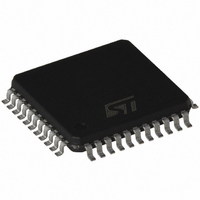ST72F561J4T6 STMicroelectronics, ST72F561J4T6 Datasheet - Page 174

ST72F561J4T6
Manufacturer Part Number
ST72F561J4T6
Description
IC MCU 8BIT 16K FLASH 44-LQFP
Manufacturer
STMicroelectronics
Series
ST7r
Datasheet
1.ST72F561K6T6.pdf
(265 pages)
Specifications of ST72F561J4T6
Core Processor
ST7
Core Size
8-Bit
Speed
8MHz
Connectivity
CAN, LINSCI, SPI
Peripherals
LVD, POR, PWM, WDT
Number Of I /o
32
Program Memory Size
16KB (16K x 8)
Program Memory Type
FLASH
Ram Size
1K x 8
Voltage - Supply (vcc/vdd)
3.8 V ~ 5.5 V
Data Converters
A/D 16x10b
Oscillator Type
External
Operating Temperature
-40°C ~ 85°C
Package / Case
44-LQFP
Processor Series
ST72F5x
Core
ST7
Data Bus Width
8 bit
Data Ram Size
1 KB
Interface Type
CAN, SCI, SPI
Maximum Clock Frequency
8 MHz
Number Of Programmable I/os
48
Number Of Timers
3
Maximum Operating Temperature
+ 85 C
Mounting Style
SMD/SMT
Development Tools By Supplier
STX-RLINK
Minimum Operating Temperature
- 40 C
On-chip Adc
10 bit, 16 Channel
For Use With
497-8374 - BOARD DEVELOPMENT FOR ST72F561
Lead Free Status / RoHS Status
Lead free / RoHS Compliant
Eeprom Size
-
Lead Free Status / Rohs Status
Details
Available stocks
Company
Part Number
Manufacturer
Quantity
Price
Company:
Part Number:
ST72F561J4T6
Manufacturer:
COILCRAFT
Quantity:
4 000
Company:
Part Number:
ST72F561J4T6
Manufacturer:
STMicroelectronics
Quantity:
10 000
- Current page: 174 of 265
- Download datasheet (10Mb)
ST72561
beCAN CONTROLLER (Cont’d)
10.9.3.7 Loop Back combined with Silent Mode
It is also possible to combine Loop Back mode and
Silent mode by setting the LBKM and SILM bits in
the CDGR register. This mode can be used for a
“Hot Selftest”, meaning the beCAN can be tested
like in Loop Back mode but without affecting a run-
ning CAN system connected to the CANTX and
CANRX pins. In this mode, the CANRX pin is dis-
connected from the beCAN and the CANTX pin is
held recessive.
Figure 99. beCAN in Combined Mode
10.9.4 Functional Description
10.9.4.1 Transmission Handling
In order to transmit a message, the application
must select one empty transmit mailbox, set up
the identifier, the data length code (DLC) and the
data before requesting the transmission by setting
the corresponding TXRQ bit in the MCSR register.
Once the mailbox has left empty state, the soft-
ware no longer has write access to the mailbox
registers. Immediately after the TXRQ bit has
been set, the mailbox enters pending state and
waits to become the highest priority mailbox, see
Transmit Priority. As soon as the mailbox has the
highest priority it will be scheduled for transmis-
sion. The transmission of the message of the
scheduled mailbox will start (enter transmit state)
when the CAN bus becomes idle. Once the mail-
box has been successfully transmitted, it will be-
come empty again. The hardware indicates a suc-
cessful transmission by setting the RQCP and
TXOK bits in the MCSR and CTSR registers.
If the transmission fails, the cause is indicated by
the ALST bit in the MCSR register in case of an Ar-
174/265
beCAN
CANTX CANRX
Tx
=1
Rx
bitration Lost, and/or the TERR bit, in case of
transmission error detection.
Transmit Priority
By Identifier:
When more than one transmit mailbox is pending,
the transmission order is given by the identifier of
the message stored in the mailbox. The message
with the lowest identifier value has the highest pri-
ority according to the arbitration of the CAN proto-
col. If the identifier values are equal, the lower
mailbox number will be scheduled first.
By Transmit Request Order:
The transmit mailboxes can be configured as a
transmit FIFO by setting the TXFP bit in the CMCR
register. In this mode the priority order is given by
the transmit request order.
This mode is very useful for segmented transmis-
sion.
Abort
A transmission request can be aborted by the user
setting the ABRQ bit in the MCSR register. In
pending or scheduled state, the mailbox is abort-
ed immediately. An abort request while the mail-
box is in transmit state can have two results. If the
mailbox is transmitted successfully the mailbox
becomes empty with the TXOK bit set in the
MCSR and CTSR registers. If the transmission
fails, the mailbox becomes scheduled, the trans-
mission is aborted and becomes empty with
TXOK cleared. In all cases the mailbox will be-
come empty again at least at the end of the cur-
rent transmission.
Non-Automatic Retransmission Mode
To configure the hardware in this mode the NART
bit in the CMCR register must be set.
In this mode, each transmission is started only
once. If the first attempt fails, due to an arbitration
loss or an error, the hardware will not automatical-
ly restart the message transmission. At the end of
the first transmission attempt, the hardware con-
siders the request as completed and sets the
RQCP bit in the MCSR register. The result of the
transmission is indicated in the MCSR register by
the TXOK, ALST and TERR bits.
Related parts for ST72F561J4T6
Image
Part Number
Description
Manufacturer
Datasheet
Request
R

Part Number:
Description:
STMicroelectronics [RIPPLE-CARRY BINARY COUNTER/DIVIDERS]
Manufacturer:
STMicroelectronics
Datasheet:

Part Number:
Description:
STMicroelectronics [LIQUID-CRYSTAL DISPLAY DRIVERS]
Manufacturer:
STMicroelectronics
Datasheet:

Part Number:
Description:
BOARD EVAL FOR MEMS SENSORS
Manufacturer:
STMicroelectronics
Datasheet:

Part Number:
Description:
NPN TRANSISTOR POWER MODULE
Manufacturer:
STMicroelectronics
Datasheet:

Part Number:
Description:
TURBOSWITCH ULTRA-FAST HIGH VOLTAGE DIODE
Manufacturer:
STMicroelectronics
Datasheet:

Part Number:
Description:
Manufacturer:
STMicroelectronics
Datasheet:

Part Number:
Description:
DIODE / SCR MODULE
Manufacturer:
STMicroelectronics
Datasheet:

Part Number:
Description:
DIODE / SCR MODULE
Manufacturer:
STMicroelectronics
Datasheet:

Part Number:
Description:
Search -----> STE16N100
Manufacturer:
STMicroelectronics
Datasheet:

Part Number:
Description:
Search ---> STE53NA50
Manufacturer:
STMicroelectronics
Datasheet:

Part Number:
Description:
NPN Transistor Power Module
Manufacturer:
STMicroelectronics
Datasheet:

Part Number:
Description:
DIODE / SCR MODULE
Manufacturer:
STMicroelectronics
Datasheet:











